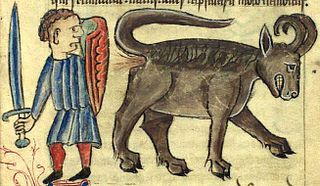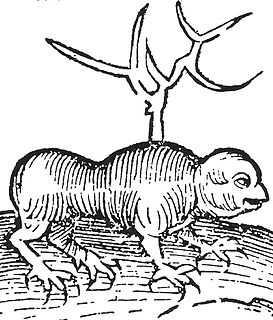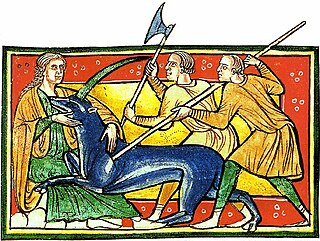Related Research Articles

The Aberdeen Bestiary is a 12th-century English illuminated manuscript bestiary that was first listed in 1542 in the inventory of the Old Royal Library at the Palace of Westminster. Due to similarities, it is often considered to be the "sister" manuscript of the Ashmole Bestiary. The connection between the ancient Greek didactic text Physiologus and similar bestiary manuscripts is also often noted. Information about the manuscript's origins and patrons are circumstantial, although the manuscript most likely originated from the 13th century and was owned by a wealthy ecclesiastical patron from north or south England. Currently, the Aberdeen Bestiary resides in the Aberdeen University Library in Scotland.

A bestiary is a compendium of beasts. Originating in the ancient world, bestiaries were made popular in the Middle Ages in illustrated volumes that described various animals and even rocks. The natural history and illustration of each beast was usually accompanied by a moral lesson. This reflected the belief that the world itself was the Word of God and that every living thing had its own special meaning. For example, the pelican, which was believed to tear open its breast to bring its young to life with its own blood, was a living representation of Jesus. Thus the bestiary is also a reference to the symbolic language of animals in Western Christian art and literature.

The unicorn is a legendary creature that has been described since antiquity as a beast with a single large, pointed, spiraling horn projecting from its forehead.

The manticore or mantichore is a Persian legendary creature similar to the Egyptian sphinx that proliferated in western European medieval art as well. It has the head of a human, the body of a lion and a tail of venomous spines similar to porcupine quills, while other depictions have it with the tail of a scorpion. There are some accounts that the spines can be shot like arrows, thus making the manticore a lethal predator. It devours its prey whole, using its triple rows of teeth, leaving no traces of its victims behind.

A cockatrice is a mythical beast, essentially a two-legged dragon or serpent-like creature with a rooster's head. Described by Laurence Breiner as "an ornament in the drama and poetry of the Elizabethans", it was featured prominently in English thought and myth for centuries.

The yale or centicore is a mythical beast found in European mythology and heraldry.

The bonnacon is a legendary creature described as a bull with inward-curving horns and a horse-like mane. Medieval bestiaries usually depict its fur as reddish-brown or black. Because its horns were useless for self-defense, the bonnacon was said to expel large amounts of caustic feces from its anus at its pursuers, burning them and thereby ensuring its escape.

The crocotta or corocotta, crocuta, or leucrocotta is a mythical dog-wolf of India or Aethiopia, linked to the hyena and said to be a deadly enemy of men and dogs.

The Ashmole Bestiary is a late 12th or early 13th century English illuminated manuscript Bestiary containing a creation story and detailed allegorical descriptions of over 100 animals. Rich colour miniatures of the animals are also included.
The muscaliet is an animal from Medieval bestiaries. Pierre de Beauvais's 13th century Bestiaire includes a description of the animal, comparing it in various aspects to hares, squirrels, weasels, moles and pigs. De Beauvais also describes the muscaliet as nesting beneath the trees it climbs, damaging them through its body heat.

The Myrmecoleon or Ant-lion is a fantastical animal from classical times, possibly derived from an error in the Septuagint version of the book of Job, reappearing in the Greek Christian Physiologus of the 3rd or 4th century A.D.

The Forest Bull, also known Ethiopian Bull and Ethiopian Forest Bull, is an animal from ancient and medieval bestiaries. According to Pliny the Elder, they were a breed of ferocious, tawny cattle living in Ethiopia, with mouths gaping open to the ears. Their horns, like a Yale's, could swivel in any direction. To fight, they raised them, after which the horns remained in this position. According to Aelian, they were called "flesh eaters" and were the most ferocious and savage of all animals. They were twice the size of regular bulls and could run at great speeds. He cites their hair as being red. No weapon could physically hurt the bulls, be it spears or arrows because even iron deflected from their skin. The forest bulls hunted herds of wild animals and horses. To protect their flocks, herdsmen who lived in the area dug deep ditches, in which the bulls would fall and consequently choke on their rage. The Troglodytae (cave-dwellers), a nearby tribe, supposedly "judged [this] to be the king of beasts, and rightly so, for it possesses the courage of a lion, the speed of a horse, the strength of a bull, and is stronger than iron."

A legendary creature is a type of fictional entity, typically a hybrid, that has not been proven and that is described in folklore, but may be featured in historical accounts before modernity.
The Ecbasis captivi is an anonymous Latin beast fable that probably dates to the middle of the 11th century, and was likely written in the Vosges region of France. It is the oldest example of a European beast fable to survive, and the first medieval European example of anthropomorphic animals. The poem is written in hexameters with Leonine internal rhyme frequently used throughout the poem. The text survives in two manuscripts, both of which now are at the Royal Library of Belgium.

The Rochester Bestiary is a richly illuminated manuscript copy of a medieval bestiary, a book describing the appearance and habits of a large number of familiar and exotic animals, both real and legendary. The animals' characteristics are frequently allegorised, with the addition of a Christian moral.

The Worksop Bestiary, also known as the Morgan Bestiary, most likely from Lincoln or York, England, is an illuminated manuscript created around 1185, containing a bestiary and other compiled medieval Latin texts on natural history. The manuscript has influenced many other bestiaries throughout the medieval world and is possibly part of the same group as the Aberdeen Bestiary, Alnwick Bestiary, St.Petersburg Bestiary, and other similar Bestiaries. Now residing in the Morgan Library & Museum in New York, the manuscript has had a long history of church, royal, government, and scholarly ownership.

Meduza, Meluza or Meluzina is a mythical creature in Russian folklore. She was depicted in a Russian lubok of the 17th or 18th century. She is described as half-woman, half-snake, or as the half-woman, half-fish creature. She is also said to be the deity of deception.
References
- ↑ von Volborth, Carl-Alexander (1996). Fabenwesen der Heraldik (in German). Stuttgart/Zurich: Belser Verlag. p. 117. ISBN 3-7630-2329-1.
- ↑ Friar, Stephen, ed. (1987). A New Dictionary of Heraldry. London: Alphabooks/A&C Black. p. 342. ISBN 0 906670 44 6.